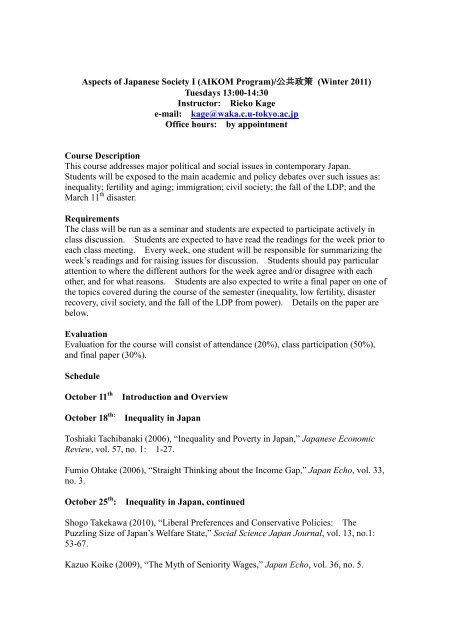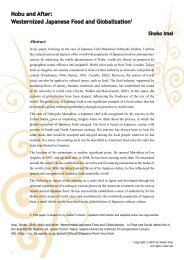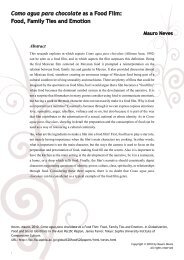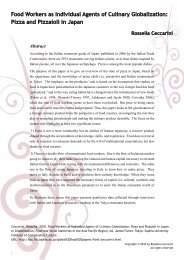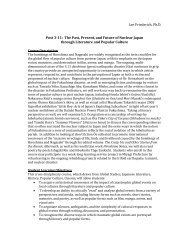Introduction to Japanese Society and Politics - Sophia University ...
Introduction to Japanese Society and Politics - Sophia University ...
Introduction to Japanese Society and Politics - Sophia University ...
Create successful ePaper yourself
Turn your PDF publications into a flip-book with our unique Google optimized e-Paper software.
Aspects of <strong>Japanese</strong> <strong>Society</strong> I (AIKOM Program)/ 公 共 政 策 (Winter 2011)<br />
Tuesdays 13:00-14:30<br />
Instruc<strong>to</strong>r: Rieko Kage<br />
e-mail: kage@waka.c.u-<strong>to</strong>kyo.ac.jp<br />
Office hours: by appointment<br />
Course Description<br />
This course addresses major political <strong>and</strong> social issues in contemporary Japan.<br />
Students will be exposed <strong>to</strong> the main academic <strong>and</strong> policy debates over such issues as:<br />
inequality; fertility <strong>and</strong> aging; immigration; civil society; the fall of the LDP; <strong>and</strong> the<br />
March 11 th disaster.<br />
Requirements<br />
The class will be run as a seminar <strong>and</strong> students are expected <strong>to</strong> participate actively in<br />
class discussion. Students are expected <strong>to</strong> have read the readings for the week prior <strong>to</strong><br />
each class meeting. Every week, one student will be responsible for summarizing the<br />
week’s readings <strong>and</strong> for raising issues for discussion. Students should pay particular<br />
attention <strong>to</strong> where the different authors for the week agree <strong>and</strong>/or disagree with each<br />
other, <strong>and</strong> for what reasons. Students are also expected <strong>to</strong> write a final paper on one of<br />
the <strong>to</strong>pics covered during the course of the semester (inequality, low fertility, disaster<br />
recovery, civil society, <strong>and</strong> the fall of the LDP from power). Details on the paper are<br />
below.<br />
Evaluation<br />
Evaluation for the course will consist of attendance (20%), class participation (50%),<br />
<strong>and</strong> final paper (30%).<br />
Schedule<br />
Oc<strong>to</strong>ber 11 th<br />
Oc<strong>to</strong>ber 18 th:<br />
<strong>Introduction</strong> <strong>and</strong> Overview<br />
Inequality in Japan<br />
Toshiaki Tachibanaki (2006), “Inequality <strong>and</strong> Poverty in Japan,” <strong>Japanese</strong> Economic<br />
Review, vol. 57, no. 1: 1-27.<br />
Fumio Ohtake (2006), “Straight Thinking about the Income Gap,” Japan Echo, vol. 33,<br />
no. 3.<br />
Oc<strong>to</strong>ber 25 th :<br />
Inequality in Japan, continued<br />
Shogo Takekawa (2010), “Liberal Preferences <strong>and</strong> Conservative Policies: The<br />
Puzzling Size of Japan’s Welfare State,” Social Science Japan Journal, vol. 13, no.1:<br />
53-67.<br />
Kazuo Koike (2009), “The Myth of Seniority Wages,” Japan Echo, vol. 36, no. 5.
2<br />
Torbern Iversen <strong>and</strong> Anne Wren (1998), “Equality, Employment, <strong>and</strong> Budgetary<br />
Restraint: The Trilemma of the Service Economy,” World <strong>Politics</strong>, vol. 50, no. 4:<br />
507-546.<br />
November 1 st : Low Fertility<br />
Sawako Shirahase (2007), “Women’s Economic Status <strong>and</strong> Fertility: Japan in<br />
Cross-National Perspective,” in Frances M. Rosenbluth, ed., The Political Economy of<br />
Japan’s Low Fertility. Stanford: Stanford <strong>University</strong> Press, ch. 2.<br />
Sawako Shirahase (2009), “Marriage as an Association of Social Classes in a Low<br />
Fertility-Rate <strong>Society</strong>,” in Hiroshi Ishida <strong>and</strong> David H. Slater, Social Class in<br />
Contemporary Japan: Structure, Sorting, <strong>and</strong> Strategies. New York: Routledge.<br />
November 8 th :<br />
Low Fertility <strong>and</strong> Aging in Comparative Context<br />
Julia Lynch (2006), Age in the Welfare State: The Origins of Social Spending on<br />
Pensioners, Workers, <strong>and</strong> Children. Cambridge: Cambridge <strong>University</strong> Press, ch. 1<br />
<strong>and</strong> 2.<br />
November 15 th :<br />
The <strong>Japanese</strong> Youth<br />
Yuji Genda (2007), “Jobless Youths <strong>and</strong> the NEET Problem in Japan,” Social Science<br />
Japan Journal, vol. 10, no. 1: 23-40.<br />
Yuki Honda (2008), “Focusing in on Japan’s ‘Youth Nationalism’,” Social Science<br />
Japan Journal, vol. 10, no. 2: 281-286.<br />
Mary C. Brin<strong>to</strong>n (2009), “Social Class <strong>and</strong> Economic Life Chances in Post-Industrial<br />
Japan: The ‘Lost Generation,’” in Hiroshi Ishida <strong>and</strong> David H. Slater, Social Class in<br />
Contemporary Japan: Structure, Sorting, <strong>and</strong> Strategies. New York: Routledge.<br />
November 22 nd : Immigration<br />
Myungsoo Kim (2003), “Ethnic Stratification <strong>and</strong> Inter-Generational Differences in<br />
Japan: A Comparative Study of Korean <strong>and</strong> <strong>Japanese</strong> Status Attainment,”<br />
International Journal of <strong>Japanese</strong> Sociology, vol. 12, no. 1: 1-11.<br />
Seung-mi Han (2004), “From the Communitarian Ideal <strong>to</strong> the Public Sphere: The<br />
making of Foreigners’ Assemblies in Kawasaki City <strong>and</strong> Kanagawa Prefecture,” Social<br />
Science Japan Journal, vol. 7, no. 1: 41-60.<br />
Bumsoo Kim (2011), “Changes in the Socio-Economic Position of Zainichi Koreans:<br />
An His<strong>to</strong>rical Overview,” Social Science Japan Journal, vol. 14, no. 2: 233-245.<br />
November 29 th :<br />
Civil <strong>Society</strong>
3<br />
Mako<strong>to</strong> Iokibe (1999), “Japan’s Civil <strong>Society</strong>: A His<strong>to</strong>rical Overview,” in Tadashi<br />
Yamamo<strong>to</strong>, ed., Deciding the Public Good: Governance <strong>and</strong> Civil <strong>Society</strong> in Japan.<br />
Tokyo: Japan Center for International Exchange: 51-96.<br />
Yuko Kawa<strong>to</strong>, Robert Pekkanen, <strong>and</strong> Hidehiro Yamamo<strong>to</strong> (2010), “State <strong>and</strong> Civil<br />
<strong>Society</strong> in Japan,” in Alisa Gaunder, ed., Routledge H<strong>and</strong>book of <strong>Japanese</strong> <strong>Politics</strong>.<br />
New York: Routledge.<br />
Susan Pharr (2003), “Conclusion: Targeting by an Activist State: Japan as a Civil<br />
<strong>Society</strong> Model,” in Frank J. Schwartz <strong>and</strong> Susan J. Pharr, eds., The State of Civil <strong>Society</strong><br />
in Japan. Cambridge: Cambridge <strong>University</strong> Press.<br />
December 6 th : Civil <strong>Society</strong> (continued)<br />
Steven K. Vogel (1999), “When Interests Are Not Preferences: The Cautionary Tale of<br />
<strong>Japanese</strong> Consumers.” Comparative <strong>Politics</strong> vol. 31, no. 2: 187-207.<br />
Kim Reimann (2003), “Building Civil <strong>Society</strong> from the Outside In? <strong>Japanese</strong><br />
International Development NGOs, the State, <strong>and</strong> International Norms,” in Frank J.<br />
Schwartz <strong>and</strong> Susan J. Pharr, eds., The State of Civil <strong>Society</strong> in Japan. Cambridge:<br />
Cambridge <strong>University</strong> Press.<br />
Mary Alice Haddad (2007), “The Transformation of Japan’s Civil <strong>Society</strong> L<strong>and</strong>scape,”<br />
Journal of East Asian Studies, vol. 7, no. 3: 413-437.<br />
December 13 th : The Fall of the LDP<br />
Chris<strong>to</strong>pher Hood (2010), “The Shinkansen’s Local Impact,” Social Science Japan<br />
Journal, forthcoming.<br />
Ellis S. Krauss <strong>and</strong> Robert Pekkanen (2010), “The Rise <strong>and</strong> Fall of Japan’s Liberal<br />
Democratic Party,” Journal of Asian Studies, vol. 69, no. 1: 5-15.<br />
Masaki Taniguchi, Hideaki Uenohara, <strong>and</strong> Shiro Sakaiya (2010), “Who Ended the<br />
LDP’s Reign?” Japan Echo, vol. 37, no. 1.<br />
December 20 th : Underst<strong>and</strong>ing the Disaster (1)<br />
Stephanie E. Chang (2010), “Urban Disaster Recovery: A Measurement Framework<br />
<strong>and</strong> its Application <strong>to</strong> the 1995 Kobe Earthquake,” Disasters, vol. 34, no. 2: 303-327.<br />
Daniel P. Aldrich (2011), “Social, not Physical, Infrastructure: The Critical Role of<br />
Civil <strong>Society</strong> after the 1923 Tokyo Earthquake,” Disasters, forthcoming.<br />
January 17 th : Underst<strong>and</strong>ing the Disaster (2)
4<br />
Richard J. Samuels (1987), The Business of the <strong>Japanese</strong> State: Energy Markets in<br />
Comparative <strong>and</strong> His<strong>to</strong>rical Perspective. Ithaca: Cornell <strong>University</strong> Press,<br />
Daniel P. Aldrich (2007), Site Fights: Divisive Facilities <strong>and</strong> Civil <strong>Society</strong> in Japan<br />
<strong>and</strong> the West. Ithaca: Cornell <strong>University</strong> Press, ch. 5: 119-151.<br />
Jacques E. C. Hymans (2011), “Ve<strong>to</strong> Players, Nuclear Energy, <strong>and</strong> Nonproliferation:<br />
Domestic Institutional Barriers <strong>to</strong> a <strong>Japanese</strong> Nuclear Bomb,” International Security,<br />
vol. 36, no. 2: 154-189.<br />
January 24 th<br />
Wrap-up<br />
Presentations:<br />
Student presentations should be 20-30 minutes in length. Students should prepare a<br />
1-2 page h<strong>and</strong>out for the class that summarizes the argument <strong>and</strong> the main points in the<br />
reading(s). In addition <strong>to</strong> summarizing the argument <strong>and</strong> the main points in the<br />
readings, the student should offer a critique of the argument advanced in the article.<br />
Do you find the argument convincing? Why or why not? To what extent does the<br />
evidence offered by the author support the argument advanced in the paper? Any<br />
additional insights from other courses, readings, anything that you know on the <strong>to</strong>pic<br />
from elsewhere are also welcome.<br />
Paper<br />
The paper should address one of the major <strong>to</strong>pics covered in the course. It should ask:<br />
on what issues do the authors covered in the course agree or disagree with each other?<br />
Which argument do you find the most convincing, <strong>and</strong> why? The paper should be 4-5<br />
pages in length (A4, double-spaced, 11 or 12 point font). You are also welcome <strong>to</strong><br />
conduct your own research on the subject or <strong>to</strong> discuss additional material that you have<br />
read in other courses or on your own. Please e-mail the paper <strong>to</strong> the instruc<strong>to</strong>r at<br />
kage@waka.c.u-<strong>to</strong>kyo.ac.jp by February 8 th , 2012, end of the day (no extensions).


